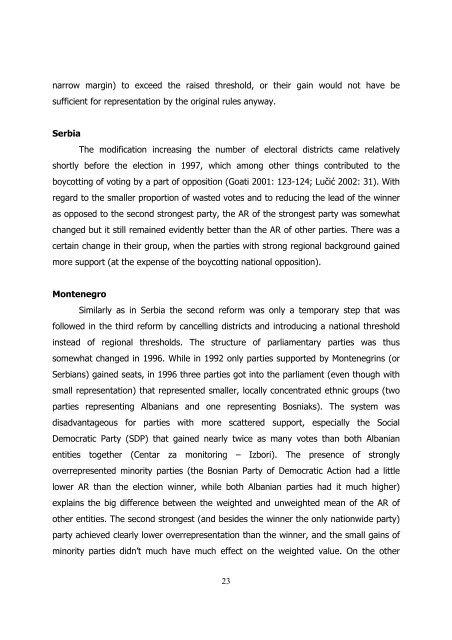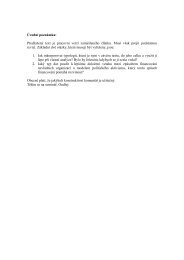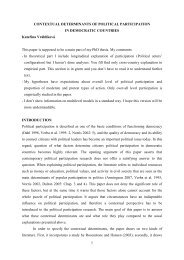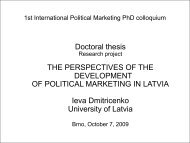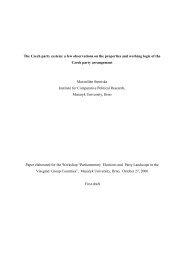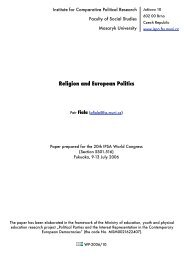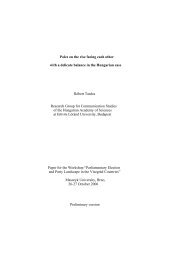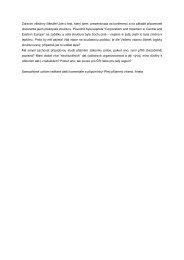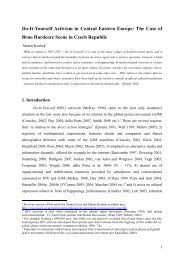Advantage Ratio as a Tool in Post-Communist Electoral Reforms ...
Advantage Ratio as a Tool in Post-Communist Electoral Reforms ...
Advantage Ratio as a Tool in Post-Communist Electoral Reforms ...
You also want an ePaper? Increase the reach of your titles
YUMPU automatically turns print PDFs into web optimized ePapers that Google loves.
narrow marg<strong>in</strong>) to exceed the raised threshold, or their ga<strong>in</strong> would not have be<br />
sufficient for representation by the orig<strong>in</strong>al rules anyway.<br />
Serbia<br />
The modification <strong>in</strong>cre<strong>as</strong><strong>in</strong>g the number of electoral districts came relatively<br />
shortly before the election <strong>in</strong> 1997, which among other th<strong>in</strong>gs contributed to the<br />
boycott<strong>in</strong>g of vot<strong>in</strong>g by a part of opposition (Goati 2001: 123-124; Lučić 2002: 31). With<br />
regard to the smaller proportion of w<strong>as</strong>ted votes and to reduc<strong>in</strong>g the lead of the w<strong>in</strong>ner<br />
<strong>as</strong> opposed to the second strongest party, the AR of the strongest party w<strong>as</strong> somewhat<br />
changed but it still rema<strong>in</strong>ed evidently better than the AR of other parties. There w<strong>as</strong> a<br />
certa<strong>in</strong> change <strong>in</strong> their group, when the parties with strong regional background ga<strong>in</strong>ed<br />
more support (at the expense of the boycott<strong>in</strong>g national opposition).<br />
Montenegro<br />
Similarly <strong>as</strong> <strong>in</strong> Serbia the second reform w<strong>as</strong> only a temporary step that w<strong>as</strong><br />
followed <strong>in</strong> the third reform by cancell<strong>in</strong>g districts and <strong>in</strong>troduc<strong>in</strong>g a national threshold<br />
<strong>in</strong>stead of regional thresholds. The structure of parliamentary parties w<strong>as</strong> thus<br />
somewhat changed <strong>in</strong> 1996. While <strong>in</strong> 1992 only parties supported by Montenegr<strong>in</strong>s (or<br />
Serbians) ga<strong>in</strong>ed seats, <strong>in</strong> 1996 three parties got <strong>in</strong>to the parliament (even though with<br />
small representation) that represented smaller, locally concentrated ethnic groups (two<br />
parties represent<strong>in</strong>g Albanians and one represent<strong>in</strong>g Bosniaks). The system w<strong>as</strong><br />
disadvantageous for parties with more scattered support, especially the Social<br />
Democratic Party (SDP) that ga<strong>in</strong>ed nearly twice <strong>as</strong> many votes than both Albanian<br />
entities together (Centar za monitor<strong>in</strong>g – Izbori). The presence of strongly<br />
overrepresented m<strong>in</strong>ority parties (the Bosnian Party of Democratic Action had a little<br />
lower AR than the election w<strong>in</strong>ner, while both Albanian parties had it much higher)<br />
expla<strong>in</strong>s the big difference between the weighted and unweighted mean of the AR of<br />
other entities. The second strongest (and besides the w<strong>in</strong>ner the only nationwide party)<br />
party achieved clearly lower overrepresentation than the w<strong>in</strong>ner, and the small ga<strong>in</strong>s of<br />
m<strong>in</strong>ority parties didn’t much have much effect on the weighted value. On the other<br />
23


